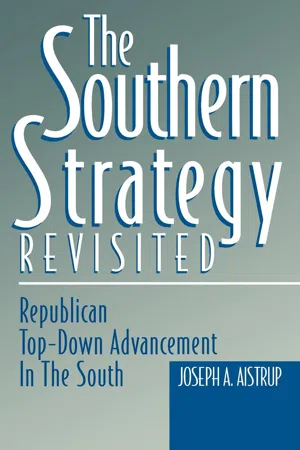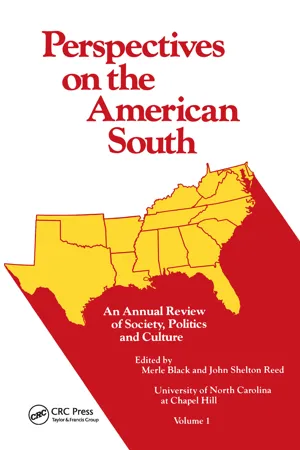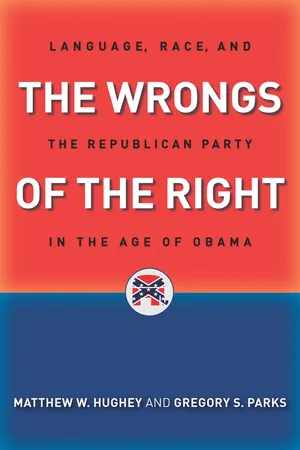History
Southern Strategy
The Southern Strategy refers to a political strategy employed by the Republican Party in the United States to appeal to white Southern voters by focusing on issues such as states' rights, law and order, and opposition to civil rights legislation. This strategy aimed to capitalize on racial tensions and the backlash against the Civil Rights Movement, ultimately leading to a shift in Southern political allegiance from the Democratic to the Republican Party.
Written by Perlego with AI-assistance
Related key terms
Related key terms
1 of 4
Related key terms
1 of 3
7 Key excerpts on "Southern Strategy"
- eBook - ePub
The Southern Strategy Revisited
Republican Top-Down Advancement in the South
- Joseph A. Aistrup(Author)
- 2021(Publication Date)
- The University Press of Kentucky(Publisher)
ECTION 1THE SOUTHERN STRATEGY IS MORE THAN JUST A RECIPE TO ATTRACT VARIOUS disparate political groupings to the Republican party’s presidential ticket; it is an ideological carrot for wooing presidential supporters into the Republican party. Reinforcing the South Strategy’s messages are the Grand Old Party’s (GOP) efforts to build on their presidential triumphs by transferring this success at the top to other levels of electoral competition (Bass and De Vries 1976, 31). Once the party has built a successful presidential coalition in a state, it concentrates its resources to build a winning coalition at the lower levels of competition—contests for the U.S. Senate, state gubernatorial offices, congressional seats, and, lastly, state legislature posts. For purposes of this book, this mode of party development is labeled as “Republican top-down advancement.”At one political level, the wisdom of this strategy is apparent. By 1980 the Republicans possessed ten of the twenty-two Senate seats, five of the eleven governorships, and little over 30 percent of the U.S. House seats (Bullock 1987). By 1994, Southern Republicans had increased their control to 13 of 22 U.S. Senate seats, 6 of 11 governorships, and 64 of 125 U.S. House seats. However, at another political level, the wisdom of this strategy is less than lucid. The conservative, sometimes racial, sometimes religious, content of the Southern Strategy’s messages entices many conservative reactionaries into the party who clash with the Republicans’ natural base, the upwardly mobile, business and professional classes who have come to typify the “new South” (Sundquist 1983, ch. 18). This has led to the situation where some Republican state parties are strife-torn and lack ideological coherence on social issues.In addition, the top-down advancement process means that while the GOP now possesses a majority of national offices and governorships, it still only controls three of twenty-two state legislative chambers. Despite this tension and its significance for the GOP’s efforts in the South, there has been a relative lack of attention among scholars as to the precise nature of this strategy and its goals, or how it is shaping the future of Southern politics. This book identifies the fundamental issues of the Southern Strategy, traces its evolution since its conception in the early 1960s, and shows how this strategy affects patterns of GOP top-down advancement in the South in ten of eleven formerly Confederate states (excluding Louisiana) from 1964 to 1994.1 - eBook - ePub
- Robert P. Jones(Author)
- 2016(Publication Date)
- Simon & Schuster(Publisher)
This cultural divide illustrates the far-reaching political and cultural consequences of White Christian America’s demise. We are witnessing the end of the era. For the first time in more than five decades, an appeal to a sentimental vision of midcentury heartland America is not a winning political strategy. To understand the post-Obama milieu, it is necessary to understand the “White Christian Strategy,” a political tactic employed primarily by the Republican Party beginning with the campaigns of Barry Goldwater and Richard Nixon in the mid-1960s and ending with Mitt Romney’s failed presidential run in 2012.From the Southern Strategy to the White Christian StrategyWhat I am calling the White Christian Strategy is an outgrowth of the Southern Strategy, a tactic developed by political conservatives and the Republican Party in the mid-1960s to appeal to white southern voters who were angry with the Democratic Party for its support of civil rights. The Southern Strategy picked up momentum through two critical transition moments, one in the 1960s and one in the 1980s, which political scientists Merle and Earl Black identified as the two iterations of the “Great White Switch.”16Prior to the civil rights movement, most white Southerners were loyal members of the Democratic Party. But with the passage of landmark civil rights legislation like the Civil Rights Act of 1964 and the Voting Rights Act of 1965, Republican Party strategists saw an opportunity to coax disgruntled white southern voters into their camp.17 The first Great White Switch began in the 1964 presidential race, when Barry Goldwater ran an explicitly anti–civil rights campaign under the Republican banner. Goldwater lost, but his run loosened the historic ties between the Democrats and the South. In that year, for the first time since the Civil War, more southern whites voted for the Republican candidate than for the Democrat, setting a precedent that has held true for every subsequent presidential election.18 In 1968, Richard Nixon struck a deal with South Carolina Senator Strom Thurmond—promising to oppose court-ordered busing to integrate schools, name a southerner to the Supreme Court, and pick someone acceptable to the South for his running mate—which secured Southern support for his campaign.19 Following Nixon’s success, Republican Party strategists continued to hone these racial wedge tactics in the South, giving them a prominent place in the GOP’s national political playbook.20 - eBook - ePub
Black in America
The Paradox of the Color Line
- Enobong Hannah Branch, Christina Jackson(Authors)
- 2020(Publication Date)
- Polity(Publisher)
Fully aware of the race-fueled disaffection of Southern Democrats, and their fear that theirs was now “the party of Blacks” in the South (Herman and Peterson 2008), Republican strategist Kevin Phillips introduced a plan to capitalize on this disaffection, literally appealing to racists by targeting anti-Black sentiments among Southern White voters (Jacobs and Tope 2008). The ensuing racialized discourse (including a renewed emphasis on crime) resonated with its target audience, and ultimately allowed Republicans to “peel large numbers of southern White voters away from the Democratic Party” (Drakulich and Crutchfield 2013:9). This migration continued from the 1970s through the end of the twentieth century, and culminated in a near-total racial split in the electorate (Hawley 2015). Despite – or, perhaps, due to – the popularity of colorblind politics, this realignment completely changed the role of race, both in policy and in the “rules of the game” of campaigning. Following the success of the “Southern Strategy” and the resulting realignment, there have been persistent, well-organized ideological and legal campaigns to scale back the gains achieved by the Civil Rights Movement, with both the means and goals of diversity under assault (Cokorinos 2003). This anti-civil rights agenda operates on the principle that the government should have little or no role in ensuring racial equity. The 1970s saw significant challenges to the policies of the 1960s, including the Bakke decision, which called into question the fairness of race as a determining factor in admissions (with implications for hiring as well) - eBook - ePub
The Persuadable Voter
Wedge Issues in Presidential Campaigns
- D. Sunshine Hillygus, Todd G. Shields(Authors)
- 2014(Publication Date)
- Princeton University Press(Publisher)
This chapter also offers a careful look at the use of wedge issues prior to the contemporary hyperinformation environment examined in the next chapter. Compared to the information available to campaign strategists today, candidates in the 1960s and 1970s largely had to infer the policy preferences of voters based on region, race, or other broad characteristics, so that strategic policy decisions were made on this rather imprecise information. Likewise, candidates’ campaign messages were primarily communicated through broadcast television or stump speeches, so that message targeting was much less precise than we see today. And stump speeches were often covered by the national press, making it more difficult to communicate unique messages to different audiences and inevitably making wedge issues part of the national campaign dialogue. Thus, given the blunt nature of campaign targeting during this era, candidates faced clear electoral tradeoffs in staking a particular position on a divisive policy, and such tradeoffs were often explicitly discussed as part of the candidates’ strategic planning during the campaign.A great deal has been written about the Republican Southern Strategy and we make no attempt to provide a complete chronology here.3 We begin this chapter with a brief historical examination of the origins of and motivations behind the Southern Strategy, but then focus our attention on empirically evaluating how changes in GOP campaign rhetoric influenced white Democratic voters, and particularly white Democrats who embraced issue positions at odds with their national party. Thus, we analyze both the extent to which Republican campaign strategies were based on reaching cross-pressured Democratic voters and the effect of emphasizing wedge issues on their voting behavior.By most accounts, the Republican Southern Strategy was successful. After losing nearly all of the southern states to the Democrats in 1960, Richard Nixon returned to carry five of eleven southern states in 1968 and won each and every Confederate state in his lopsided 1972 presidential victory. The Republicans’ improved showing across the South is often taken as evidence that the Southern Strategy was effective at winning over southern Democrats. For many observers, the twelve years between Nixon’s loss in 1960 and his landslide victory in 1972 represented the beginning and end of the transformation of the once solidly Democratic South to the current GOP stronghold.4 Much of the rich literature on southern politics focuses on the partisan realignment of the South during this time period, as the conservative South switched allegiances from the Democratic to the Republican Party.5 - eBook - ePub
Perspectives on the American South
An Annual Review of Society, Politics, and Culture
- Merle Black, John Shelton Reed(Authors)
- 2021(Publication Date)
- Routledge(Publisher)
A second difficulty in estimating the cohesiveness of the white vote lies in the fact that data on black cohesiveness exist for the region through the SRC/CPS national surveys but are ordinarily unavailable for individual states or subregions. I have employed the regional percentage for the partisan distribution of the black vote in a given election for each state and subregion and have thereby ignored any interstate or intersubregional differences in the partisan division of the black vote. However, in view of the exceptionally skewed distribution of the black vote that has existed in recent presidential elections, with almost all blacks voting Democratic, it is doubtful that there have been significant variations among the states or subregions in patterns of black solidarity.The Republican Southern Strategy
It is scarcely hyperbole to describe the central tendency of Republican efforts in the South since the early 1960s as an attempt to construct a new "white man's party."10 Even though none of the Republican candidates from Goldwater to Ford openly campaigned in the explicitly segregationist style so common in southern politics through the mid-1960s, the working assumption of most Republican activists has been that whites, especially the region's more conservative whites, should be the primary targets of Republican campaign efforts.An electoral strategy that ignores almost totally one sizeable bloc of voters while concentrating on a second group must assume that the latter group will vote with sufficient unity to compensate for the absence of support from the first group. In terms of Republican strategy, the larger the size and the greater the cohesiveness of the black vote conceded to the Democrats, the larger the white majority required by the Republican candidate to win a given electoral unit. Estimates of the minimum white vote needed for a Republican majority as well as estimates of the percentage of the total white vote actually won by each Republican presidential nominee in the 1964-76 elections are presented in Table 2 - eBook - ePub
Politics and Society in Modern America
Mississippi and the Conservative Counterrevolution
- Joseph Crespino(Author)
- 2021(Publication Date)
- Princeton University Press(Publisher)
Chapter Seven Southern Strategies in MississippiIN 1964, the challenge of the Mississippi Freedom Democratic Party to the traditional all-white Mississippi delegation combined with Mississippi’s record vote for Barry Goldwater marked a watershed year in Mississippi and American politics. The migration of white Mississippians from the Democratic to the Republican Party, however, did not flow inevitably from those seminal events. Party realignment in Mississippi was a process full of contingency, conflict, and uncertainty. In the years following the Atlantic City challenge, liberal Democrats, including African Americans, labor, and a handful of white liberals, struggled to forge a more progressive biracial coalition in the Mississippi Democratic Party. They did not achieve all that they wanted, but their efforts, combined with dictates coming from the national party, elicited a more moderate white leadership among Mississippi Democrats, one that by the 1970s was resolutely committed to biracial Democratic Party politics.In the Republican Party, conservative and moderate Republicans in both the state and national party were divided over the question of how vigorously the GOP should pursue southern Dixiecrat voters. To many national observers, President Nixon’s election in 1968 and his administration’s close attention to the concerns of segregationist leaders in a state like Mississippi led to charges that the administration was pursuing a “Southern Strategy.” When asked about such a strategy, Richard Nixon readily admitted that he targeted white southern voters, but he distinguished between the Deep South states that Barry Goldwater won in 1964 and the border South states that helped put Nixon over the top four years later. Nixon argued that by going after “foam-at-the-mouth segregationists,” Goldwater weakened Republican appeals among moderates. For Nixon, at least in retrospect, the Southern Strategy meant targeting not the segregationist Dixiecrat followers of George Wallace but rather moderate suburban and upper South whites who readily identified with the fiscal and social conservatism of the Republican Party.1 - eBook - ePub
The Wrongs of the Right
Language, Race, and the Republican Party in the Age of Obama
- Matthew W. Hughey, Gregory S. Parks(Authors)
- 2014(Publication Date)
- NYU Press(Publisher)
8These appeals and rhetorical strategies were based around the societal norm of white supremacy. Due to the widespread belief in racial inequality, Democrats were able to campaign on direct attacks on blacks’ supposed inferior biological and cultural traits to justify their stance against granting rights to African Americans, while Republicans had to justify their support for granting rights to blacks without violating the norm of inequality. Republican explicit racial appeals were used to reinforce the belief in white superiority over minorities and were often embedded in important stances toward taxes, immigration, labor, and voting.9A party’s rhetorical strategy is formed around that party’s stance on a given issue and the societal norms in existence. Societal norms are reflections of the political and social trends surrounding the election period. During the nineteenth century, the widespread use of slavery in the South created the norm of racial inequality to which parties had to conform in order to achieve electoral success. However, with the passage of the Fourteenth and Fifteenth amendments, there was a brief period in which the short-lived norm of racial equality allowed limited political equality between races. During this time, Democrats were restrained from making explicit appeals on the issue of race. The widespread use of slavery in the American colonies led to the deeply rooted racial dispositions of the country. Due to the racial hierarchy established by the institution of slavery, a national assumption of black inferiority emerged. Abolitionists and their opponents both agreed on the inadequacy of blacks, but the groups did not agree on what they believed the cause to be. Abolitionists believed that with the aid of the government, this racial shortfall could be treated in order to liberate slaves from servitude. Many of these advocates, however, paired this idea with the need for segregation of the races due to African Americans’ inability to qualify for full equality.10
Index pages curate the most relevant extracts from our library of academic textbooks. They’ve been created using an in-house natural language model (NLM), each adding context and meaning to key research topics.
Explore more topic indexes
Explore more topic indexes
1 of 6
Explore more topic indexes
1 of 4






